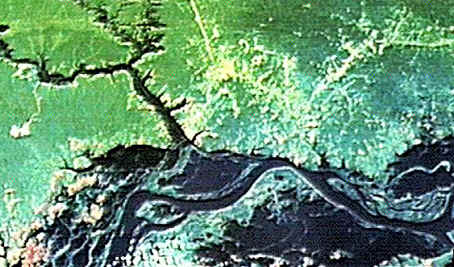
This is an aerial photograph of an area in the Lower Middle Amazon. The dark parts are rivers and lakes. Moving from left to right is the Amazon river and from top left down to mid is the Trombetas river. The area of my fieldwork is the triangle in the middle of the picture with the lake in the middle. Obidos and Oriximiná, two towns of about 20000 inhabitants are the yellowy areas in the centre top half.A road and many settlements log it join the two towns. It is about 120 km from one end of the picture to the other. The Costa do Parú, coast of Parú to give its full name, runs roughly east-west along the banks of the River Amazon for about 32 kilometres (about 20 miles). To the immediate north lies a series of lakes and floodplain ground of various heights, which also are part of the complex of Parú. The whole area is effectively a triangle, with rivers acting as the boundaries, on the south side the Amazon and on either side the Trombetas and Cachoerri rivers. However, the area known as Parú by locals refers only to the Costa do Parú; the other sides of the triangle have other names. The triangle is effectively a receptacle, with various out/inlets: the lake being the water trapped inside. The sides of the triangle are the natural river embankments or the floodplain levées (restinga). These are the highest ground of the floodplain and it is usually only upon the levees that houses are built. 
Although this is a case study, my idea is to make it a window thorugh which to view a number of issues. The concreteness gives focus to the broader concerns you may be interested in following through.
The history of the colonisation of Parú is quite heterogeneous, comprising of international (Italian and Portuguese) and regional migration, and internal growth. According to oral histories the demographic increase has been steady and it is only towards the end of the twentieth century that all the available land has been fully occupied and used. This is in contrast to urban centres in Amazonia which, in the last thirty years, have grown remarkably. It is highly probable that Parú became an important rural satellite of Obidos, especially given the importance of cattle ranching in the area.
Many of the oldest inhabitants in Parú attest that their grandparents were born and brought up there. This takes Parú's occupation at least as far back as the mid-nineteenth century. It would perhaps not be inconceivable on this basis to speculate that the development of rural areas such as Parú date from before the Cabanagem (1835) and to the end of the directorate period (1798), when there was general dispersion to rural areas from the mission villages. The general demographic growth and waves of Portuguese (around 1855) and Italian migration (beginning of 20th century - many people claim to have grandparents born in Italy) would have further lead to the demographic expansion of Parú.
There is no common origin story for the inhabitants of Parú. There are individual family histories, such as where they came from and where they lived. Typically such stories revolve around a sibling group who worked and lived together, setting up on a plot of land that is still occupied by the descendants of original set. In general terms, contemporary residents of Parú are an outcome of people who settled there at the beginning of the nineteenth century. In turn these families grew, spreading out onto new areas of land. Newcomers drifted into the area and gained occupational legitimacy, that is rights to land and other resources, through marriage with locals.
On numerous occasions I was told that before they lived on Parú, `Indians' used to work and live there, disque os Ìndios morravam aqui. I always followed this question up with, `what happened to them, then?' Again the answer was invariably, eles foram embora, they went away. I could never decide to what extent this was a response learnt as part of the dominant history or a vital oral tradition that formed part of their sense of self and other. A few Parúaros claim descent from Indians, I suspect not more did because of the low status such an association carries. Invariably, these people would say their ancestors were women, índias, who had a child with European man. Most added that such relationships go a long way back, to their avós, bisavós or tetra-avós (grandparents, great grandparents and great-great grandparents). No particular ethnic identity was ascribed to the women and they were not described as having lost their `Indian-ness'. Quite simply such an identity was described in terms of `my mother/ or grandmother told me that her mother/ or grandmother was Indian'.